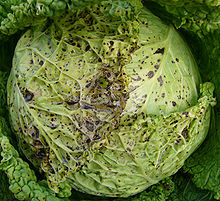Tymoviridae
| Tymoviridae | |
|---|---|
| Virus classification | |
| (unranked): | Virus |
| Realm: | Riboviria |
| Kingdom: | Orthornavirae |
| Phylum: | Kitrinoviricota |
| Class: | Alsuviricetes |
| Order: | Tymovirales |
| Family: | Tymoviridae |
| Genera | |

Tymoviridae is a family of single-stranded positive sense RNA viruses in the order Tymovirales. Plants serve as natural hosts. There are 42 species in this family, assigned to three genera, with two species unassigned to a genus.[1][2]
Taxonomy
[edit]The family includes the following three genera:[2]
Additionally, the following two species are not assigned to a genus:[2]
Proposed viruses
[edit]Virology
[edit]The virions are non-enveloped and isometric with a diameter of around 30 nm, with an icosahedral structure and a triangulation number T=3.[1]
The linear genome is between of 6–7.5 kilobases in length[1] and encodes one large open reading frame. It is capped at the 5’ terminus. The 3’ terminus may have a tRNA-like structure or a polyA tract, depending upon the species. The genome is relatively cytosine rich.[citation needed]
| Genus | Structure | Symmetry | Capsid | Genomic arrangement | Genomic segmentation |
|---|---|---|---|---|---|
| Maculavirus | Icosahedral | T=3 | Non-enveloped | Linear | Monopartite |
| Marafivirus | Icosahedral | T=3 | Non-enveloped | Linear | Monopartite |
| Tymovirus | Icosahedral | T=3 | Non-enveloped | Linear | Monopartite |
Life cycle
[edit]Viral replication is cytoplasmic, and is lysogenic. Entry into the host cell is achieved by penetration into the host cell. Replication follows the positive stranded RNA virus replication model. Positive stranded RNA virus transcription is the method of transcription. Translation takes place by leaky scanning. The virus exits the host cell by monopartite non-tubule guided viral movement. Plants serve as the natural host. The virus is transmitted via a vector (insects). Transmission routes are vector and mechanical.[1]
| Genus | Host details | Tissue tropism | Entry details | Release details | Replication site | Assembly site | Transmission |
|---|---|---|---|---|---|---|---|
| Maculavirus | Plants | None | Viral movement; mechanical inoculation | Viral movement | Cytoplasm | Cytoplasm | Mechanical inoculation: pseudococcid mealybugs; Mechanical inoculation: aphids |
| Marafivirus | Plants | None | Viral movement; mechanical inoculation | Viral movement | Cytoplasm | Cytoplasm | Mechanical inoculation: pseudococcid mealybugs; Mechanical inoculation: aphids |
| Tymovirus | Plants | None | Viral movement; mechanical inoculation | Viral movement | Cytoplasm | Cytoplasm | Mechanical: beetles; sap |
References
[edit]- ^ a b c d "Viral Zone". ExPASy. Retrieved 15 June 2015.
- ^ a b c "Virus Taxonomy: 2020 Release". International Committee on Taxonomy of Viruses (ICTV). March 2021. Retrieved 15 May 2021.
- ^ Wang L, Lv X, Zhai Y, Fu S, Wang D, Rayner S, Tang Q, Liang G (2012) Genomic characterization of a novel virus of the family tymoviridae isolated from mosquitoes. PLoS One 7(7):e39845.
Further reading
[edit]- Martelli GP. Sabanadzovic S. Abou-Ghanem Sabanadzovic N. Edwards MC. Dreher T. (2002). The family Tymoviridae. Archives of Virology. 147(9):1837-46
- University of Leicester Microbiology
